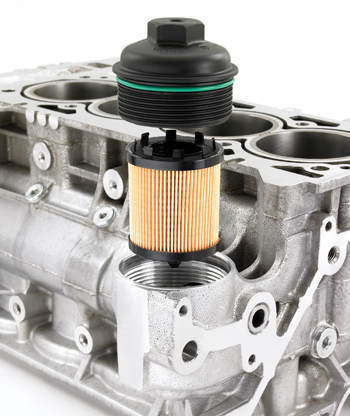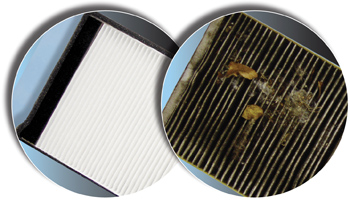Filters have long been a common maintenance item. But with longer factory service intervals and “lifetime” filters becoming more common, how often do filters really need to be replaced?
There’s no simple answer. The safest advice used to be to follow the filter service interval recommendations in the vehicle owner’s manual (assuming the owner’s manual hasn’t been lost and that somebody will actually read it!). The problem with this recommendation is that some filters no longer have a service interval (such as most fuel and transmission filters), and the factory recommended service intervals for some filters and fluids (motor oil and filter for example) may be overly optimistic and don’t take into account the kind of driving many motorists actually do.
A filter’s main purpose is to trap abrasive particles before they can do any harm. That’s true of air filters, oil filters, fuel filters and transmission filters. As for cabin air filters, their purpose can be two-fold: to keep dirt and grit out of the HVAC system and passenger compartment, and to absorb and trap unpleasant odors before they enter the vehicle (in the case of dual-purpose cabin air filters).
All filters, even “lifetime” ones, have a limited service life and eventually become clogged with dirt, wear particles, rust and other debris. So, the idea behind preventive maintenance is to change your customers’ filter before it reaches that point.
 The most often replaced filter is the oil filter. It usually gets changed every 3,000 to 7,500 miles on most vehicles (except in Europe where they use different motor oils and typically go for a once-a-year oil change). On many late-model vehicles, oil change intervals have been extended from the traditional 3,000 miles or six months, to 5,000 to 7,500 miles or more.
The most often replaced filter is the oil filter. It usually gets changed every 3,000 to 7,500 miles on most vehicles (except in Europe where they use different motor oils and typically go for a once-a-year oil change). On many late-model vehicles, oil change intervals have been extended from the traditional 3,000 miles or six months, to 5,000 to 7,500 miles or more.
On vehicles that employ a maintenance reminder light to signal when an oil change is needed, the reminder light may not come on for up to 15,000 miles or more, depending on all the operating variables the software considers when making its estimate. On some vehicles, additional input from an electrical sensor in the oil pan may help detect oil that is breaking down or is heavily contaminated with moisture.
An important point to keep in mind with respect to extended oil change intervals is that many of these intervals are based on using high-quality synthetic motor oil rather than conventional motor oil, and a premium-quality oil filter which typically use a synthetic media that outperforms most conventional cellulose filter media.
Air filters also have much longer replacement intervals these days — assuming the motorist is not driving in an extremely dusty environment or on rural gravel roads. The typical factory recommended service interval for many air filters these days is typically 30,000 to 50,000 miles. A realistic recommendation for air filter service on your customers’ vehicle is to inspect it at every oil change, and to replace it as needed, even if the factory service interval has not yet been reached.
As for fuel filters, inline fuel filters should be replaced for preventive maintenance every three to five years or 50,000 miles to reduce the risk of fuel restrictions and a clogged filter. For tank-mounted fuel filters, the filter should be replaced if the fuel pump is being replaced for any reason. New fuel pump modules usually come with a new filter as part of the assembly, but if you’re replacing the pump separately, you should also change the filter and pickup screen.
Transmission filters should be changed if the transmission fluid is being replaced, if repairs are being made to the transmission, or if the transmission oil cooler or lines are being replaced to keep contaminants out of the transmission.
For dust-only cabin air filters, inspecting and replacing the filter every 15,000 to 30,000 miles is usually adequate, except for rural areas or dusty environments. For odor-absorbing cabin air filters, the service life is about a year before the carbon granules become saturated and lose their ability to remove odors.
—————————————————————————————————————————————–
The Importance of Changing Cabin Air Filters
 Cabin air filters are designed to protect the most important part of the vehicle — passengers. Refer to the following tips when explaining to customers how cabin filters can help them, and their vehicles, breathe easier.
Cabin air filters are designed to protect the most important part of the vehicle — passengers. Refer to the following tips when explaining to customers how cabin filters can help them, and their vehicles, breathe easier.
Blocks contaminants — Designed to capture contaminants like soot, dirt and odors, cabin air filters are the first line of defense against airborne pollutants entering a vehicle in motion. When the filter is dirty or clogged, less air passes through the filter, making it harder to keep the air clean and flowing. Pollutants can cause a variety of problems, from headaches to allergies. Extends vehicle performance — A dirty cabin air filter can result in decreased heating, air conditioning and windshield defroster performance caused by restricted airflow through the filter. Improper servicing or continued use of a clogged filter may also hinder a vehicle’s HVAC performance and shorten the life of vital system components. Vehicle recommendations vary, but the general guideline for replacing cabin filters is every 12,000 to 15,000 miles, or annually.


